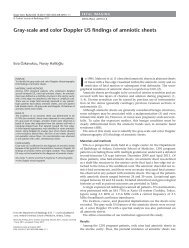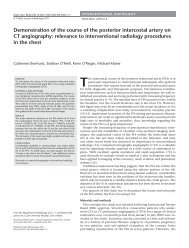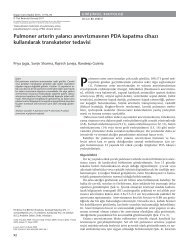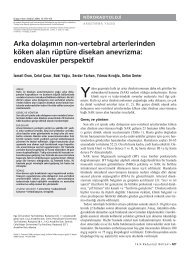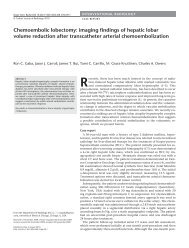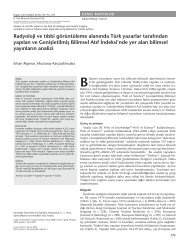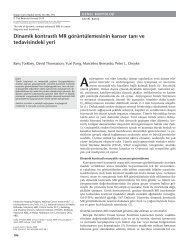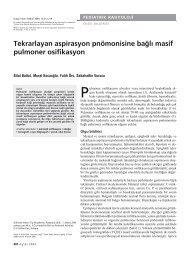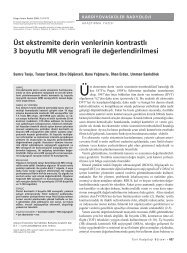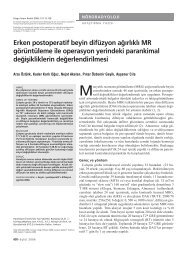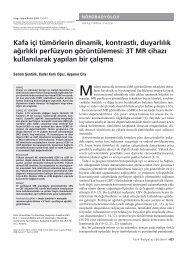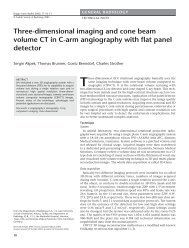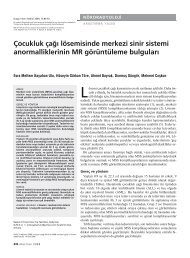Radiological report: expectations of clinicians - Diagnostic and ...
Radiological report: expectations of clinicians - Diagnostic and ...
Radiological report: expectations of clinicians - Diagnostic and ...
Create successful ePaper yourself
Turn your PDF publications into a flip-book with our unique Google optimized e-Paper software.
Reporting in Turkish terms has been<br />
an issue in radiological <strong>report</strong>s in Turkey<br />
for years. Recently, a number <strong>of</strong><br />
reviews (10–13) have recommended<br />
the use <strong>of</strong> Turkish terms in radiological<br />
<strong>report</strong>s, which is in opposition to our<br />
study. Indeed, the present study found<br />
that most <strong>clinicians</strong> do not want the<br />
patients to read the <strong>report</strong>s, <strong>and</strong> they<br />
stated that the use <strong>of</strong> universal medical<br />
terms between medical doctors supported<br />
better communication.<br />
We also determined that opinions<br />
on issues such as marking a lesion on<br />
the film <strong>and</strong> transporting the <strong>report</strong> to<br />
the clinician in a way that does not<br />
allow the patient to see the content<br />
<strong>of</strong> the <strong>report</strong> (e.g., by courier) were<br />
widely accepted by radiologists but<br />
not agreed upon by <strong>clinicians</strong>. We<br />
determined that <strong>clinicians</strong> expected<br />
sections <strong>of</strong> the <strong>report</strong>s to be complete<br />
<strong>and</strong> expected a section describing recommendations.<br />
Additionally, most <strong>of</strong><br />
the <strong>clinicians</strong> stated that they wanted<br />
to communicate with radiologists via<br />
consultation before <strong>and</strong> after the radiologic<br />
examination.<br />
Limitations <strong>of</strong> our study included<br />
the general limitations <strong>of</strong> studies based<br />
on questionnaires. A primary limitation<br />
is that this was a sampling study<br />
conducted only around Bursa, Turkey.<br />
Therefore, we cannot claim that it represents<br />
all <strong>of</strong> the <strong>clinicians</strong> around the<br />
whole country or world. Additionally,<br />
the experimental groups were heterogeneous<br />
groups containing many specialties.<br />
Different results would likely<br />
be obtained if the questionnaire were<br />
used in a larger, more homogenous<br />
group (e.g., neurologists, surgeons).<br />
The present study also contained some<br />
subjectivity, which is a common feature<br />
<strong>of</strong> studies based on questionnaires.<br />
The accuracy <strong>of</strong> the answers is only<br />
possible if the subjects answer honestly.<br />
This accuracy, however, cannot be<br />
tested objectively with a questionnaire<br />
method.<br />
We believe that the present study<br />
provided essential data for radiologists<br />
to write more effective <strong>report</strong>s. If this<br />
questionnaire was modified <strong>and</strong> applied<br />
to a larger, more homogenous<br />
group, it would be possible to test our<br />
results <strong>and</strong> obtain new data.<br />
Acknowledgement<br />
We would like to express our gratitude to<br />
Ercan Tuncel, MD, who gave us the opportunity<br />
to complete our study. The preparation <strong>of</strong><br />
the manuscript would not have been possible<br />
without his support.<br />
References<br />
1. Tuncel E. Radyogramların değerlendirilmesi<br />
ve rapor yazma. Tani Girisim Radyol 1996;<br />
2:5–10.<br />
2. Özsunar Y, Çetin M, Taşkın F, et al. The<br />
level <strong>of</strong> quality <strong>of</strong> radiology services in<br />
Turkey: a sampling analysis. Diagn Interv<br />
Radiol 2006; 12:166–170.<br />
3. Gagliardi RA. The evolution <strong>of</strong> the X-<br />
ray <strong>report</strong>. AJR Am J Roentgenol 1995;<br />
164:501–502.<br />
4. McLoughlin RF, So CB, Gray RR, Br<strong>and</strong>t<br />
R. Radiology <strong>report</strong>s: how much descriptive<br />
detail is enough? AJR Am J Roentgenol<br />
1995; 165:803–806.<br />
5. Schreiben MH, Leonard JM, Rieniets CY.<br />
Disclosure <strong>of</strong> imaging findings to patients<br />
directly by radiologists: survey <strong>of</strong> patients’<br />
preferences. AJR Am J Roentgenol 1995;<br />
165:467–469.<br />
6. Stavema K, Fossa T, Botnmarka O,<br />
Andersend OK, Erikssenb J. Inter-observer<br />
agreement in audit <strong>of</strong> quality <strong>of</strong> radiology<br />
requests <strong>and</strong> <strong>report</strong>s. Clin Radiol 2004;<br />
59:1018–1024.<br />
7. Clinger NJ, Hunter TB, Hillman BJ.<br />
Radiology <strong>report</strong>ing: attitudes <strong>of</strong> referring<br />
physicians. Radiology 1988; 169:825–826.<br />
8. Naik SS, Hanbidge A, Wilson SR. Radiology<br />
<strong>report</strong>s: examining radiologist <strong>and</strong> clinician<br />
preferences regarding style <strong>and</strong> content.<br />
AJR Am J Roentgenol 2001; 176:591–598.<br />
9. Lafortune M, Breton G, Baudouin J. The<br />
radiological <strong>report</strong>: what is useful for the<br />
referring physician? J Can Assoc Radiol<br />
1988; 39:140–143.<br />
10. Aydıngöz Ü. Radyoloji dili: temel<br />
sorunlarımız. Tani Girisim Radyol 2003;<br />
9:5–9.<br />
11. Akan H. Tıpça üzerine Türkçe düşünceler.<br />
Tani Girisim Radyol 2003; 9:131–134.<br />
12. Berkmen YM. Bilim dilinin Türkçeleşmesi.<br />
Tani Girisim Radyol 2003; 9:275–278.<br />
13. Işık S. Bilim dili Türkçe. Tani Girisim<br />
Radyol 2004;10:93–95.<br />
Volume 16 • Issue 3<br />
<strong>Radiological</strong> <strong>report</strong>: <strong>expectations</strong> <strong>of</strong> <strong>clinicians</strong> • 185



